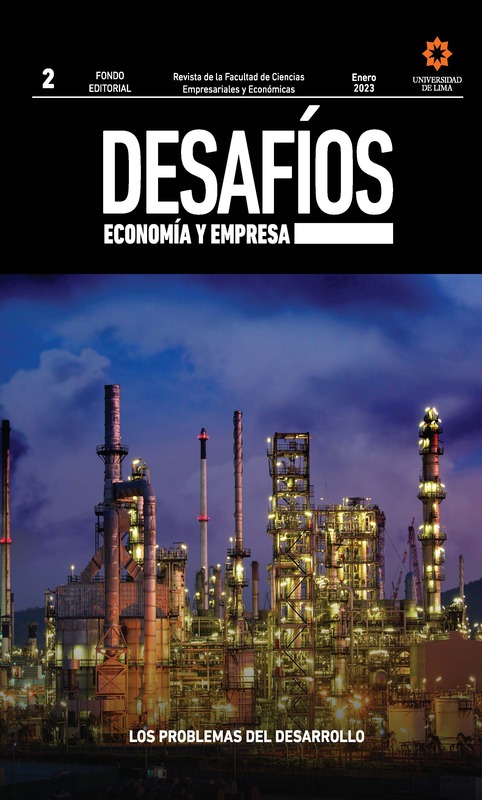Defense of the Minsky’s financial instability hypothesis
DOI:
https://doi.org/10.26439/ddee2022.n002.5816Keywords:
Minsky moment, financial crisis, financial markets, efficient markets, Big GovernmentAbstract
Recent episodes have shown the considerable fragility of the financial system, which could lead to deep economic recessions. In this respect, Hyman Minsky proposed the financial instability hypothesis, which explains how the system goes through three moments (hedge, speculative, and Ponzi), thus generating financial crises in an endogenous way. Therefore, Minsky defended the role of government regulation since financial institutions fail to preserve their stability. Given this, we evaluated four critiques of this view from the perspectives of Austrian theory, economic policy, the efficient markets hypothesis, and the issue of the big government. We found that the financial instability hypothesis significantly contributes to understanding financial markets' tendency to crises and how to stabilize the system through regulation.
Downloads
References
Aizenman, J. (2009). Financial crisis and the paradox of under-and over-regulation. National Bureau of Economic Research. (Working paper 15018). https://doi.org/10.3386/w15018
Barnes, P. (2011). Minsky’s financial instability hypothesis, accounting information and the 2007-9 financial crisis in the UK and US. Accounting History, 16(4), 423-437. https://doi.org/10.1177/1032373211417991
Bianchi, J. (2016). Efficient bailouts? American Economic Review, 106(12), 3607-3659. https://mfm.uchicago.edu/wp-content/uploads/2020/06/Bianchi-Javier-Efficient-Bailouts.pdf
Bresser-Pereira, L. (2010). The 2008 financial crisis and neoclassical economics. Brazilian Journal of Political Economy 30(1), 3-26. https://www.scielo.br/j/rep/a/pKHbwQtYnQWxCQgFZcbH8tk/?lang=en&format=pdf
Charles, S. (2016). Is Minsky’s financial instability hypothesis valid? Cambridge Journal of Economics, 40(2), 427-436. https://doi.org/10.1093/CJE/BEV022
Crotty, J. (2009). Structural causes of the global financial crisis: a critical assessment ofthe ‘new financial architecture’. Cambridge Journal of Economics, 33(4), 563-580. https://doi.org/10.1093/cje/bep023
Dam, L., & Koetter, M. (2012). Bank bailouts and moral hazard: evidence from Germany.The Review of Financial Studies, 25(8), 2343-2380. https://doi.org/10.1093/rfs/hhs05628
Dickens, E. (1999). A political-economic critique of Minsky’s financial instability hypothesis: The case of the 1966 financial crisis. Review of Political Economy, 11(4), 379-398. https://doi.org/10.1080/095382599106850
Duchin, R., & Sosyura, D. (2014). Safer ratios, riskier portfolios: Banks' response to government aid. Journal of Financial Economics, 113(1), 1-28. https://doi.org/10.1016/j.jfineco.2014.03.005
Engels, F. (1847). Principios del comunismo. https://www.marxists.org/espanol/me/1840s/47-princi.htm
Fama, E. F. (1970). Efficient capital markets: a review of theory and empirical work. The Journal of Finance, 25(2), 383-417. https://doi.org/10.1111/j.1540-6261.1970.tb00518.x
Farhi, E., & Tirole, J. (2012). Collective moral hazard, maturity mismatch, and systemic bailouts. American Economic Review, 102(1), 60-93. https://doi.org/10.1257/aer.102.1.60
Ghani, S. (2011). A re-visit to Minsky after 2007 financial meltdown. 2e Journée doctorale d’économie, Association des doctorants de Grenoble en économie, École doctorale de sciences économiques, MSH-Alpes, Grenoble, France. https://halshs.archives-ouvertes.fr/halshs-01027435/document
Instituto Juan de Mariana (2 de enero del 2017). Juan Ramón Rallo - Los errores de Hyman Minsky [Video]. YouTube. https://www.youtube.com/watch?v=TMcQ4YiinP0
Ioannou, S., & Wójcik, D. (2021). Finance and growth nexus: an international analysis across cities. Urban Studies, 58(1), 223-242. https://doi.org/10.1177/0042098019889244
Keen, S. (1995). Finance and economic breakdown: modelling Minsky’s “financial instability hypothesis”. Journal of Post Keynesian Economics, 17(4), 607-635. https://doi.org/10.1080/01603477.1995.11490053
Keen, S. (2009). Bailing out the Titanic with a thimble. Economic Analysis and Policy, 39(1), 3-24. https://keenomics.s3.amazonaws.com/debtdeflation_media/papers/v39_i1_2_keen.pdf
Keister, T. (2016). Bailouts and financial fragility. The Review of Economic Studies, 83(2),704-736. Oxford University Press. https://doi.org/10.1093/restud/rdv044
Keynes, J. M. (1936). The general theory of employment, interest and money. Macmillan.https://www.files.ethz.ch/isn/125515/1366_keynestheoryofemployment.pdf
Keynes, J. M. (1937). The general theory of employment. The Quarterly Journal of Economics, 51(2), 209-223. https://doi.org/10.2307/1882087
Keynes, J. M. (1978). The collected writings of John Maynard Keynes. En E. Johnson y D. Moggridge (Eds.), Royal Economic Society.
Knell, M. (2015). Schumpeter, Minsky and the financial instability hypothesis.Journal of Evolutionary Economics, 25(1), 293–310. https://doi.org/10.1007/s00191-014-0370-8
Marx, K. (1867). El capital. Tomo I. https://www.marxists.org/espanol/m-e/capital/karlmarx-el-capital-tomo-i-editorial-progreso.pdf
Mazumder, M. I., & Ahmad, N. (2010). Greed, financial innovation or laxity of regulation? A close look into the 2007-2009 financial crisis and stock market volatility. Studies in Economics and Finance, 27(2), 110-134. https://doi.org/10.1108/10867371011048616
Minsky, H. (1982). Can “it” happen again? Essays on instability and finance. Routledge. http://www.italjani.com/wp-content/uploads/2012/09/Minsky-Can-It-happen-again.pdf
Minsky, H. (1986). Stabilizing an unstable economy. Yale University Press. http://digamo.free.fr/minsky86.pdf
Minsky, H. (1992). The financial instability hypothesis. The Jerome Levy Economics Institute of Bard College. (Working paper 74). https://www.levyinstitute.org/pubs/wp74.pdf
Ohanian, L. (2010). The economic crisis from a neoclassical perspective. Journal of Economic Perspectives, 24(4), 45-66. https://doi.org/10.1257/jep.24.4.45
Pirie, S., & Chan, R. (2016). Following momentum and avoiding the “Minsky moment” evidence from investors on the financial instability hypothesis. Qualitative Research in Financial Markets, 8(3), 205-217. https://doi.org/10.1108/QRFM-08-2015-0034
Pólvora, J. (2018). Momentum investing: a stylized model [Tesis de maestría]. Nova School of Business and Economics. https://run.unl.pt/bitstream/10362/35443/1/Martins_2018.pdf
Ramírez, K. (2011). Análisis del libro “Teoría del desenvolvimiento económico”, de Joseph A. Schumpeter. Contribuciones a la economía, (2011-05).
Schumpeter, J. (1928). The instability of capitalism. The Economic Journal, 38(151), 361-386. https://doi.org/10.2307/2224315
Stiglitz, J. (2006). Cómo hacer que funcione la globalización. Taurus. https://doi.org/10.15581/015.11.33520
Thaler, R. H., & Sunstein, C. R. (2009). Nudge: improving decisions about health, wealth, and happiness Penguin Books. https://www.economicsnetwork.ac.uk/iree/v8n1/hoyt.pdf
The Decision Lab. (2021). Why do we think a random event is more or less likely to occur if it happened several times in the past? The Decision Lab. https://thedecisionlab.com/biases/gamblers-fallacy
Urbina, D. A. (2015). Economía para herejes: desnudando los mitos de la economía ortodoxa. CreateSpace.
Urbina, D. A. (marzo del 2018). “Hyman Minsky”. Círculo Académico de Economistas Bicentenario. https://economistasbicentenario.blogspot.com/2018/03/hymanminsky-entrevista-al-prof-dante.html
Von Mises, L. (1949). Human action: a treatise of economics. Yale University Press. https://oll.libertyfund.org/title/greaves-human-action-a-treatise-on-economics-fee-ed
Von Mises, L. (1912). The Theory of Money and Credit. Verlag von Duncker & Humblot. https://oll.libertyfund.org/title/mises-the-theory-of-money-and-credit
Weusten, P. (2012). Gambling biases. Applied to investment decisions. [Graduate thesis, Tilburg University]. Tilburg University Repository. http://arno.uvt.nl/show.cgi?fid=122725
Wolfson, M. H. (1986). Financial crises: understanding the postwar U.S. experience. M. E. Sharpe.
Yoguel, G., Barletta, F., & Pereira, M. (2013). De Schumpeter a los postschumpeterianos: viejas y nuevas dimensiones analíticas. Problemas del Desarrollo, 44(174), 35-59. https://doi.org/10.1016/S0301-7036(13)71887-X


